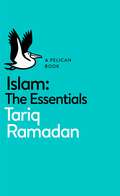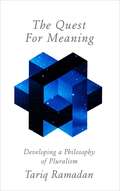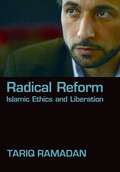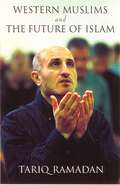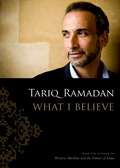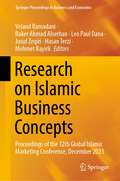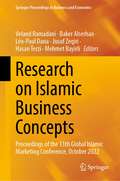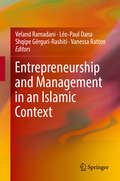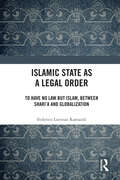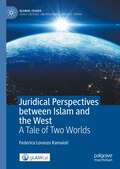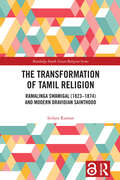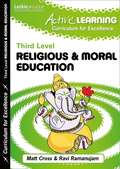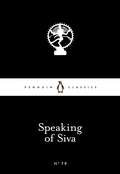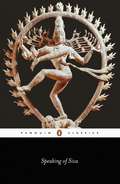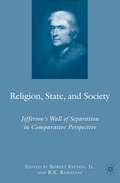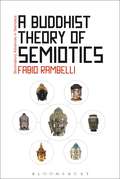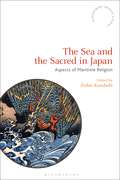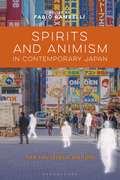- Table View
- List View
Islam: The Essentials
by Tariq RamadanThe essential introduction to Islam by a leading expertHardly a day goes by without mention of Islam. And yet, for most people, and in much of the world, Islam remains a little-known religion. Whether the issue is violence, terrorism, women's rights or slavery, Muslims are today expected to provide answers and to justify what Islam is - or is not. But little opportunity exists, either in the media or in society as a whole, to describe Islam: precisely the question this short and extremely accessible book sets out to answer. In simple, direct language it will introduce readers to Islam, to its spirituality, its principles, its rituals, its diversity and its evolution.
The Quest for Meaning: Developing a Philosophy of Pluralism
by Tariq RamadanIn The Quest for Meaning, Tariq Ramadan, philosopher and Islamic scholar, invites the reader to join him on a journey to the deep ocean of religious, secular, and indigenous spiritual traditions to explore the most pressing contemporary issues. Along the way, Ramadan interrogates the concepts that frame current debates including: faith and reason, emotions and spirituality, tradition and modernity, freedom, equality, universality, and civilization. He acknowledges the greatest flashpoints and attempts to bridge divergent paths to a common ground between these religious and intellectual traditions. He calls urgently for a deep and meaningful dialogue that leads us to go beyond tolerant co-existence to mutual respect and enrichment. Written in a both direct and meditative style this is an important, timely and intelligent book that aims to direct and shape debate around the most important questions of our time.
Radical Reform: Islamic Ethics and Liberation
by Tariq RamadanTariq Ramadan has emerged as one of the foremost voices of reformist Islam in the West, notable for urging his fellow Muslims to participate fully in the civil life of the Western societies in which they live. In this new book, Ramadan addresses Muslim societies and communities everywhere with a bold call for radical reform. He challenges those who argue defensively that reform is a dangerous and foreign deviation, and a betrayal of the faith. Authentic reform, he says, has always been grounded in Islam's textual sources, spiritual objectives, and intellectual traditions. But the reformist movements that are based on renewed reading of textual sources while using traditional methodologies and categories have achieved only adaptive responses to the crisis facing a globalizing world. Such readings, Ramadan argues, have reached the limits of their usefulness. Ramadan calls for a radical reform that goes beyond adaptation to envision bold and creative solutions to transform the present and the future of our societies. This new approach interrogates the historically established sources, categories, higher objectives, tools, and methodologies of Islamic law and jurisprudence, and the authority this traditional geography of knowledge has granted to textual scholars. He proposes a new geography which redefines the sources and the spiritual and ethical objectives of the law creating room for the authority of scholars of the social and hard sciences. This will equip this transformative reform with the spiritual, ethical, social and scientific knowledge necessary to address contemporary challenges. Ramadan argues that radical reform demands not only the equal contributions of scholars of both the text and the context, but the critical engagement and creative imagination of the Muslim masses. This proposal for radical reform dramatically shifts the center of gravity of authority. It is bound to provoke controversy and spark debate among Muslims and non-Muslims alike.
Western Muslims and the Future of Islam
by Tariq RamadanTariq Ramadan, one of Europe's leading thinkers and one of Islam's most innovative and important voices, explores in this volume what it means to be a Western Muslim, addressing a topic that is vitally important to the futures of both Islam and the West. Ramadan claims that a silent revolution is sweeping Islamic communities in the West, as Muslims actively seek ways to live in harmony with their faith within a Western context. French, English, German, and American Muslims--women as well as men--are reshaping their religion into one that is faithful to the principles of Islam, dressed in European and American cultures, and definitively rooted in Western societies.
Western Muslims and the Future of Islam
by Tariq RamadanTariq Ramadan, one of Europe's leading thinkers and one of Islam's most innovative and important voices, explores in this volume what it means to be a Western Muslim, addressing a topic that is vitally important to the futures of both Islam and the West. Ramadan claims that a silent revolution is sweeping Islamic communities in the West, as Muslims actively seek ways to live in harmony with their faith within a Western context. French, English, German, and American Muslims--women as well as men--are reshaping their religion into one that is faithful to the principles of Islam, dressed in European and American cultures, and definitively rooted in Western societies.
What I Believe
by Tariq RamadanTariq Ramadan is very much a public figure, named one of Time magazine's most important innovators of the twenty-first century. He is among the leading Islamic thinkers in the West, with a large following around the world. But he has also been a lightning rod for controversy. Indeed, in 2004, Ramadan was prevented from entering the U.S. by the Bush administration and despite two appeals, supported by organizations like the American Academy of Religion and the ACLU, he was barred from the country until spring of 2010, when Secretary of State Hillary Clinton finally lifted the ban. In What I Believe, Ramadan attempts to set the record straight, laying out the basic ideas he stands for in clear and accessible prose. He describes the book as a work of clarification, directed at ordinary citizens, politicians, journalists, and others who are curious (or skeptical) about his positions. Aware that that he is dealing with emotional issues, Ramadan tries to get past the barriers of prejudice and misunderstanding to speak directly, from the heart, to his Muslim and non-Muslim readers alike. In particular, he calls on Western Muslims to escape the mental, social, cultural, and religious ghettos they have created for themselves and become full partners in the democratic societies in which they live. At the same time, he calls for the rest of us to recognize our Muslim neighbors as citizens with rights and responsibilities the same as ours. His vision is of a future in which a shared and confident pluralism becomes a reality at last.
What I Believe
by Tariq RamadanTariq Ramadan is very much a public figure, named one of Time magazine's most important innovators of the twenty-first century. He is among the leading Islamic thinkers in the West, with a large following around the world. But he has also been a lightning rod for controversy. Indeed, in 2004, Ramadan was prevented from entering the U.S. by the Bush administration and despite two appeals, supported by organizations like the American Academy of Religion and the ACLU, he was barred from the country until spring of 2010, when Secretary of State Hillary Clinton finally lifted the ban. In What I Believe, Ramadan attempts to set the record straight, laying out the basic ideas he stands for in clear and accessible prose. He describes the book as a work of clarification, directed at ordinary citizens, politicians, journalists, and others who are curious (or skeptical) about his positions. Aware that that he is dealing with emotional issues, Ramadan tries to get past the barriers of prejudice and misunderstanding to speak directly, from the heart, to his Muslim and non-Muslim readers alike. In particular, he calls on Western Muslims to escape the mental, social, cultural, and religious ghettos they have created for themselves and become full partners in the democratic societies in which they live. At the same time, he calls for the rest of us to recognize our Muslim neighbors as citizens with rights and responsibilities the same as ours. His vision is of a future in which a shared and confident pluralism becomes a reality at last.
Research on Islamic Business Concepts: Proceedings of the 12th Global Islamic Marketing Conference, December 2021 (Springer Proceedings in Business and Economics)
by Veland Ramadani Baker Ahmad Alserhan Leo Paul Dana Jusuf Zeqiri Hasan Terzi Mehmet BayirliThis book presents selected chapters from the proceedings of the 12th Global Islamic Marketing Conference (June 2021). The chapters provide an up-to-date overview of research and insights into Islamic business practices in general and Islamic marketing strategies in particular. Papers include topics such as understanding Muslim consumer behavior, services marketing, implications and implementation of Halal business practices, social media marketing, ecommerce strategies, and overall business strategy. This book is helpful for researchers interested in the specialties of the topic and also for business consultants who wish to have an in-depth understanding of doing business in Islam-oriented regions.
Research on Islamic Business Concepts: Proceedings of the 13th Global Islamic Marketing Conference, October 2022 (Springer Proceedings in Business and Economics)
by Veland Ramadani Baker Alserhan Léo-Paul Dana Jusuf Zeqiri Hasan Terzi Mehmet BayirliThis proceedings volume presents selected chapters from the 13th Global Islamic Marketing Conference, featuring contributions from renowned experts from around the world. The chapters offer an up-to-date overview of research and insights into Islamic business practices, with a specific focus on Islamic marketing and entrepreneurship strategies. Authored by experts hailing from diverse countries such as Malaysia, Indonesia, India, Pakistan, United Arab Emirates, Jordan, and Morocco, the chapters collectively provide a comprehensive understanding of the subject matter. Covering a wide range of topics including understanding Muslim consumer behavior and marketing, halal tourism and healthcare, entrepreneurship and business in Muslim societies, women empowerment and entrepreneurship, Islamic ethics and values in organizations, psychological factors and social issues, technology and future trends, and social and labor issues in Muslim societies, this book encompasses a global perspective on the subject matter. With the expertise and diverse backgrounds of the contributing authors, this book serves as an invaluable resource for researchers interested in delving into the intricacies of Islamic business practices. It also offers valuable insights and practical implications for business consultants seeking a deep understanding of conducting business in Islam-oriented regions. The collective knowledge and experiences shared by these renowned experts contribute to a comprehensive exploration of the topic, making this volume a significant contribution to the field of Islamic marketing and business studies.
Entrepreneurship and Management in an Islamic Context
by Veland Ramadani Léo-Paul Dana Shqipe Gërguri-Rashiti Vanessa RattenThe aim of this volume is to explore entrepreneurship and business from the perspective of Islamic principles, which are usually based on collaboration, teamwork, generosity and altruism. The contributions deal with the confluence of Islamic Principles with entrepreneurial and business ownership characteristics; resource use by entrepreneurs; means of entrepreneurial success, and ethics and social responsibility.
Islamic State as a Legal Order: To Have No Law but Islam, between Shari’a and Globalization
by Federico Lorenzo RamaioliThis book explores the legal dimension of the Islamic State, an aspect which has hitherto been neglected in the literature. ISIS’ dystopian experience, intended as a short-lived territorial and political governance, has been analyzed from multiple points of view, including the geopolitical, social and religious ones. However, its legal dimension has never been properly dealt with in a comprehensive way, assuming as a point of reference both the Islamic and the Western legal tradition. This book analyzes ISIS as the expression of a potential though never fully realized legal order. The book does not describe ISIS’ possible classifications according to the standards and the criteria of international law, such as its possible statehood or proto-statehood, issues that are however touched upon. Rather, it analyzes ISIS’ own legal awareness, based on the group’s literary materials, which show a considerable amount of juridical work. Such material, mainly propagandistic in its nature, is essential in understanding which kind of legal order ISIS aimed at establishing. The book will be of interest to students and academics in the fields of Law, International Relations, Political Sciences, Terrorism Studies, Religion and Middle Eastern Studies.
Islamic State as a Legal Order: To Have No Law but Islam, between Shari’a and Globalization
by Federico Lorenzo RamaioliThis book explores the legal dimension of the Islamic State, an aspect which has hitherto been neglected in the literature. ISIS’ dystopian experience, intended as a short-lived territorial and political governance, has been analyzed from multiple points of view, including the geopolitical, social and religious ones. However, its legal dimension has never been properly dealt with in a comprehensive way, assuming as a point of reference both the Islamic and the Western legal tradition. This book analyzes ISIS as the expression of a potential though never fully realized legal order. The book does not describe ISIS’ possible classifications according to the standards and the criteria of international law, such as its possible statehood or proto-statehood, issues that are however touched upon. Rather, it analyzes ISIS’ own legal awareness, based on the group’s literary materials, which show a considerable amount of juridical work. Such material, mainly propagandistic in its nature, is essential in understanding which kind of legal order ISIS aimed at establishing. The book will be of interest to students and academics in the fields of Law, International Relations, Political Sciences, Terrorism Studies, Religion and Middle Eastern Studies.
Juridical Perspectives between Islam and the West: A Tale of Two Worlds (Global Issues)
by Federico Lorenzo RamaioliThis comparative philosophy of law book aims at formulating a new analytical approach to the Islamic legal tradition based on ‘juridical categories’, a concept that facilitates comprehension and understanding of juridical phenomena. Building upon legal comparativism and legal pluralism, this project intends to avoid bias caused by universalizing Western categories when analyzing foreign juridical notions, which inevitably results in the miscomprehension of non-Western ideas and institutions. Unlike existing literature, this project will not focus on substantive comparisons between normative contents, but on the ‘juridical perspectives’ that helped to shape the Islamic and Western legal orders.The book focuses on the most relevant juridical questions regarding the Islamic and Western legal perspectives, such as the different visions regarding juridical spatiality, the role of human reason and the relationship between law, man and the divinity. While contributing to legal philosophy, this work intends also to develop and define a new interdisciplinary approach, aiming to provide a starting point for novel analyses in research fields such as legal comparativism, legal pluralism, and constitutional law. Finally, by formulating a new interdisciplinary approach, it will provide a foundational discussion of a continuously evolving subject that will never be exhaustively explored. As such, it aims at broadening scholarly reflections on the relationship between the West and Islam, eventually placing these concepts within a suitably comprehensive and contextualized framework. "Published in cooperation with gLAWcal - Global Law Initiatives for Sustainable Development, Hornchurch, Essex, United Kingdom".
The Transformation of Tamil Religion: Ramalinga Swamigal (1823–1874) and Modern Dravidian Sainthood (Routledge South Asian Religion Series)
by Srilata RamanThis book analyses the religious ideology of a Tamil reformer and saint, Ramalinga Swamigal of the 19th century and his posthumous reception in the Tamil country and sheds light on the transformation of Tamil religion that both his works and the understanding of him brought about. The book traces the hagiographical and biographical process by which Ramalinga Swamigal is shifted from being considered an exemplary poet-saint of the Tamil Śaivite bhakti tradition to a Dravidian nationalist social reformer. Taking as a starting point Ramalinga’s own writing, the book presents him as inhabiting a border zone between early modernity and modernity, between Hinduism and Christianity, between colonialism and regional nationalism, highlighting the influence of his teachings on politics, particularly within Dravidian cultural and political nationalism. Simultaneously, the book considers the implication of such an hagiographical process for the transformation of Tamil religion in the period between the 19th –mid-20th centuries. The author demonstrates that Ramalinga Swamigal’s ideology of compassion, cīvakāruṇyam, had not only a long genealogy in pre-modern Tamil Śaivism but also that it functioned as a potentially emancipatory ethics of salvation and caste critique not just for him but also for other Tamil and Dalit intellectuals of the 19th century. This book is a path-breaking study that also traces the common grounds between the religious visions of two of the most prominent subaltern figures of Tamil modernity – Iyothee Thass and Ramalingar. It argues that these transformations are one meaningful way for a religious tradition to cope with and come to terms with the implications of historicization and the demands of colonial modernity. It is, therefore, a valuable contribution to the field of religion, South Asian history and literature and Subaltern studies. The Open Access version of this book, available at http://www.taylorfrancis.com/books/e/9781315794518 has been made available under a Creative Commons Attribution-Non Commercial-No Derivatives 4.0 license.
The Transformation of Tamil Religion: Ramalinga Swamigal (1823–1874) and Modern Dravidian Sainthood (Routledge South Asian Religion Series)
by Srilata RamanThis book analyses the religious ideology of a Tamil reformer and saint, Ramalinga Swamigal of the 19th century and his posthumous reception in the Tamil country and sheds light on the transformation of Tamil religion that both his works and the understanding of him brought about. The book traces the hagiographical and biographical process by which Ramalinga Swamigal is shifted from being considered an exemplary poet-saint of the Tamil Śaivite bhakti tradition to a Dravidian nationalist social reformer. Taking as a starting point Ramalinga’s own writing, the book presents him as inhabiting a border zone between early modernity and modernity, between Hinduism and Christianity, between colonialism and regional nationalism, highlighting the influence of his teachings on politics, particularly within Dravidian cultural and political nationalism. Simultaneously, the book considers the implication of such an hagiographical process for the transformation of Tamil religion in the period between the 19th –mid-20th centuries. The author demonstrates that Ramalinga Swamigal’s ideology of compassion, cīvakāruṇyam, had not only a long genealogy in pre-modern Tamil Śaivism but also that it functioned as a potentially emancipatory ethics of salvation and caste critique not just for him but also for other Tamil and Dalit intellectuals of the 19th century. This book is a path-breaking study that also traces the common grounds between the religious visions of two of the most prominent subaltern figures of Tamil modernity – Iyothee Thass and Ramalingar. It argues that these transformations are one meaningful way for a religious tradition to cope with and come to terms with the implications of historicization and the demands of colonial modernity. It is, therefore, a valuable contribution to the field of religion, South Asian history and literature and Subaltern studies. The Open Access version of this book, available at http://www.taylorfrancis.com/books/e/9781315794518 has been made available under a Creative Commons Attribution-Non Commercial-No Derivatives 4.0 license.
Active Learning — Active Religious and Moral Education: Third Level (PDF)
by Ravi Ramanujam Matthew Cross Leckie Leckie StaffCovering the Third Level Outcomes and Experiences for Religious and Moral Education, this book provides cross curricular links, rich tasks, interdisciplinary project ideas and applications to everyday life to help you effectively implement Curriculum for Excellence. Focusing on building both subject specific and higher order thinking skills, Active RME contains a toolkit of ideas to help you effectively implement Curriculum for Excellence. It contains rich tasks, interdisciplinary project ideas, applications to everyday life and assessment checklists to embed pupils’ knowledge and develop their skills.
Speaking of Siva
by A. K. Ramanujan'To the utterly at-one with Sivathere's no dawn.'Meditative, deeply personal poems to the god Siva, from four major Hindu saints.Introducing Little Black Classics: 80 books for Penguin's 80th birthday. Little Black Classics celebrate the huge range and diversity of Penguin Classics, with books from around the world and across many centuries. They take us from a balloon ride over Victorian London to a garden of blossom in Japan, from Tierra del Fuego to 16th-century California and the Russian steppe. Here are stories lyrical and savage; poems epic and intimate; essays satirical and inspirational; and ideas that have shaped the lives of millions.Mahadeviyakka (10th century), Basavaa, Devara Dasimayya and Allama Prabhu (12th century).
Speaking of Siva
by A. K. RamanujanSpeaking of Siva is a selection of vacanas or free-verse sayings from the Virasaiva religious movement, dedicated to Siva as the supreme god. Written by four major saints, the greatest exponents of this poetic form, between the tenth and twelfth centuries, they are passionate lyrical expressions of the search for an unpredictable and spontaneous spiritual vision of 'now'. Here, yogic and tantric symbols, riddles and enigmas subvert the language of ordinary experience, as references to night and day, sex and family relationships take on new mystical meanings. These intense poems of personal devotion to a single deity also question traditional belief systems, customs, superstitions, image worship and even moral strictures, in verse that speaks to all men and women regardless of class and caste.
Religion, State, and Society: Jefferson's Wall of Separation in Comparative Perspective
by R. Ramazani Robert FattonThe book examines the relationship between religion and state in a comparative perspective with special attention paid to Western and Middle-Eastern experiences. It examines the resurgence of 'fundamentalism' not only in developing nations but also in economically affluent 'post-modern' societies.
A Buddhist Theory of Semiotics: Signs, Ontology, and Salvation in Japanese Esoteric Buddhism (Bloomsbury Advances in Semiotics)
by Fabio RambelliOne of the first attempts ever to present in a systematic way a non-western semiotic system. This book looks at Japanese esoteric Buddhism and is based around original texts, informed by explicit and rigorous semiotic categories. It is a unique introduction to important aspects of the thought and rituals of the Japanese Shingon tradition.Semiotic concerns are deeply ingrained in the Buddhist intellectual and religious discourse, beginning with the idea that the world is not what it appears to be, which calls for a more accurate understanding of the self and reality. This in turn results in sustained discussions on the status of language and representations, and on the possibility and methods to know reality beyond delusion; such peculiar knowledge is explicitly defined as enlightenment. Thus, for Buddhism, semiotics is directly relevant to salvation; this is a key point that is often ignored even by Buddhologists. This book discusses in depth the main elements of Buddhist semiotics as based primarily on original Japanese pre-modern sources. It is a crucial publication in the fields of semiotics and religious studies.
A Buddhist Theory of Semiotics: Signs, Ontology, and Salvation in Japanese Esoteric Buddhism (Bloomsbury Advances in Semiotics #2)
by Fabio RambelliOne of the first attempts ever to present in a systematic way a non-western semiotic system. This book looks at Japanese esoteric Buddhism and is based around original texts, informed by explicit and rigorous semiotic categories. It is a unique introduction to important aspects of the thought and rituals of the Japanese Shingon tradition.Semiotic concerns are deeply ingrained in the Buddhist intellectual and religious discourse, beginning with the idea that the world is not what it appears to be, which calls for a more accurate understanding of the self and reality. This in turn results in sustained discussions on the status of language and representations, and on the possibility and methods to know reality beyond delusion; such peculiar knowledge is explicitly defined as enlightenment. Thus, for Buddhism, semiotics is directly relevant to salvation; this is a key point that is often ignored even by Buddhologists. This book discusses in depth the main elements of Buddhist semiotics as based primarily on original Japanese pre-modern sources. It is a crucial publication in the fields of semiotics and religious studies.
The Sea and the Sacred in Japan: Aspects of Maritime Religion (Bloomsbury Shinto Studies)
by Fabio RambelliThe Sea and the Sacred in Japan is the first book to focus on the role of the sea in Japanese religions. While many leading Shinto deities tend to be understood today as unrelated to the sea, and mountains are considered the privileged sites of sacredness, this book provides new ways to understand Japanese religious culture and history. Scholars from North America, Japan and Europe explore the sea and the sacred in relation to history, culture, politics, geography, worldviews and cosmology, space and borders, and ritual practices and doctrines. Examples include Japanese indigenous conceptualizations of the sea from the Middle Ages to the 20th century; ancient sea myths and rituals; sea deities and sea cults; the role of the sea in Buddhist cosmology; and the international dimension of Japanese Buddhism and its maritime imaginary.
The Sea and the Sacred in Japan: Aspects of Maritime Religion (Bloomsbury Shinto Studies)
by Fabio RambelliThe Sea and the Sacred in Japan is the first book to focus on the role of the sea in Japanese religions. While many leading Shinto deities tend to be understood today as unrelated to the sea, and mountains are considered the privileged sites of sacredness, this book provides new ways to understand Japanese religious culture and history. Scholars from North America, Japan and Europe explore the sea and the sacred in relation to history, culture, politics, geography, worldviews and cosmology, space and borders, and ritual practices and doctrines. Examples include Japanese indigenous conceptualizations of the sea from the Middle Ages to the 20th century; ancient sea myths and rituals; sea deities and sea cults; the role of the sea in Buddhist cosmology; and the international dimension of Japanese Buddhism and its maritime imaginary.
Spirits and Animism in Contemporary Japan: The Invisible Empire
by Fabio RambelliThis book draws attention to a striking aspect of contemporary Japanese culture: the prevalence of discussions and representations of “spirits” (tama or tamashii). Ancestor cults have played a central role in Japanese culture and religion for many centuries; in recent decades, however, other phenomena have expanded and diversified the realm of Japanese animism. For example, many manga, anime, TV shows, literature, and art works deal with spirits, ghosts, or with an invisible dimension of reality. International contributors ask to what extent these are cultural forms created by the media for consumption, rather than manifestations of “traditional” ancestral spirituality in their adaptations to contemporary society. Spirits and Animism in Contemporary Japan considers the modes of representations and the possible cultural meanings of spirits, as well as the metaphysical implications of contemporary Japanese ideas about spirits. The chapters offer analyses of specific cases of “animistic attitudes” in which the presence of spirits and spiritual forces is alleged, and attempt to trace cultural genealogies of those attitudes. In particular, they present various modes of representation of spirits (in contemporary art, architecture, visual culture, cinema, literature, diffuse spirituality) while at the same time addressing their underlying intellectual and religious assumptions.
Spirits and Animism in Contemporary Japan: The Invisible Empire
by Fabio RambelliThis book draws attention to a striking aspect of contemporary Japanese culture: the prevalence of discussions and representations of “spirits” (tama or tamashii). Ancestor cults have played a central role in Japanese culture and religion for many centuries; in recent decades, however, other phenomena have expanded and diversified the realm of Japanese animism. For example, many manga, anime, TV shows, literature, and art works deal with spirits, ghosts, or with an invisible dimension of reality. International contributors ask to what extent these are cultural forms created by the media for consumption, rather than manifestations of “traditional” ancestral spirituality in their adaptations to contemporary society. Spirits and Animism in Contemporary Japan considers the modes of representations and the possible cultural meanings of spirits, as well as the metaphysical implications of contemporary Japanese ideas about spirits. The chapters offer analyses of specific cases of “animistic attitudes” in which the presence of spirits and spiritual forces is alleged, and attempt to trace cultural genealogies of those attitudes. In particular, they present various modes of representation of spirits (in contemporary art, architecture, visual culture, cinema, literature, diffuse spirituality) while at the same time addressing their underlying intellectual and religious assumptions.
